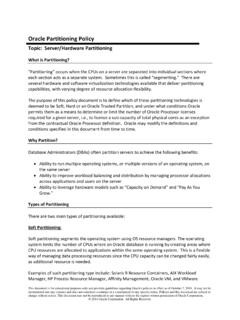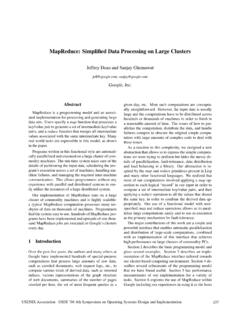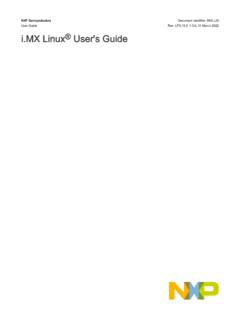Transcription of PetaLinux Tools Documentation: Reference Guide
1 PetaLinux ToolsDocumentationReference GuideUG1144 ( ) June 16, 2021 See all versionsof this documentRevision HistoryThe following table shows the revision history for this Summary06/16/2021 Version 7: Customizing the ProjectAdded a new section: Configuring UBIFS 5: Booting and PackagingUpdated Steps to Boot a PetaLinux Image on hardware withSD A: MigrationAdded FPGA Manager Changes, Yocto Recipe NameChanges, Host GCC Version 10: Advanced ConfigurationsUpdated U-Boot Configuration and Image HistoryUG1144 ( ) June 16, 2021 Tools Documentation Reference Guide 2 Send FeedbackTable of ContentsRevision 1: Content by Design 2: Setting Up Your 11 Installation Working Environment 15 Design Flow 3: Creating a Creation Using PetaLinux hardware Platform with Vivado Design hardware Platform to PetaLinux 22 Creating an Empty Project from a 4.
2 Configuring and hardware System Boot Image for Versal Boot Image for Zynq UltraScale+ Boot Image for Zynq-7000 Boot Image for MicroBlaze Bitstream File for MicroBlaze 34 Build 5: Booting and Prebuilt PetaLinux -boot Command with Prebuilt a PetaLinux Image on a PetaLinux Image on hardware with an SD ( ) June 16, 2021 Tools Documentation Reference Guide 3 Send FeedbackBoot a PetaLinux Image on hardware with a PetaLinux Image on hardware with 6: Upgrading the Between Minor Releases ( Tool with Tool) ..89 Upgrading the Installed Tool with More the Installed Tool with your Customized 7: Customizing the Version File System Type Images Storage Flash Partition Image INITRD 99 Configuring INITRAMFS 100 Configure TFTP NFS JFFS2 UBIFS 105 Configuring SD Card ext File System 8.
3 Customizing the Root File 112 Including Prebuilt Prebuilt 114 Creating and Adding Custom User and Adding Custom and Adding Custom Kernel User User User Auto Auto Run at an Existing Recipe into the Root File a Package Root File System ( ) June 16, 2021 Tools Documentation Reference Guide 4 Send FeedbackChapter 9: the Linux Kernel in Applications with TCF Zynq UltraScale+ MPSoC and Versal ACAP Applications with 138 Debugging Individual PetaLinux 10: Advanced Menuconfig Source Bootgen for On-target Use for Zynq Devices, Versal ACAP, and ZynqUltraScale+ Out-of-tree Project 171 Chapter 11: Yocto Generation (Target Sysroot Generation).
4 176 Accessing BitBake/Devtool in a State Variant RootFS Packages Based on and Adding Patches For Software Components within a PetaLinux Extra Users to the PetaLinux 185 Adding Auto login Option in the PetaLinux 12: Technical ..187 Appendix A: microblaze_lite 198U-Boot Image Tar Files for Kernel and U-Boot PetaLinux -build -b Bitbake over Devtool for PetaLinux -config Distroboot Support for MicroBlaze ( ) June 16, 2021 Tools Documentation Reference Guide 5 Send FeedbackU-Boot Configuration Linux the Advanced Bootable Images Storage to PetaLinux -boot Settings to the Ethernet Package Environment Variables in PetaLinux -config login Option for PetaLinux Manager Recipe Name GCC Version B: PetaLinux Project 205 Project 208 Appendix C.
5 Generating Boot Loader and Manager Firmware (PLM).. 209 Processing System Management Firmware (PSM)..210 Image Stage Boot Loader for Zynq UltraScale+ and Zynq-7000 Trusted Firmware (ATF)..212 PMU for MicroBlaze Platform D: QEMU Virtual Networking the QEMU Virtual 215 Appendix E: Xilinx IP Models Supported by 216 Appendix F: Xen Zynq UltraScale+ MPSoC and Versal Prebuilt Linux as Built Linux as 219 Appendix G: Booting Prebuilt ( ) June 16, 2021 Tools Documentation Reference Guide 6 Send FeedbackAppendix H: partitioning and Formatting an SD 222 Appendix I: Auto-mounting an SD J: PetaLinux K: Additional Resources and Legal 262 Xilinx Navigator and Design Read.
6 Important Legal 263UG1144 ( ) June 16, 2021 Tools Documentation Reference Guide 7 Send FeedbackChapter 1 OverviewIntroductionPetaLinux is an embedded Linux Software Development Kit (SDK) targeting FPGA-based system-on-a-chip (SoC) designs. This Guide helps the reader to familiarize with the tool enabling overallusage of are assumed to have basic Linux knowledge, such as how to run Linux commands. Youshould be aware of OS and host system features, such as OS version, Linux distribution, securityprivileges, and basic Yocto PetaLinux tool contains: Yocto Extensible SDK (eSDK) XSCT (Xilinx Software Command-Line Tool) and toolchains PetaLinux CLI toolsNote: Vitis unified software platform is the integrated design environment (IDE) for creating embeddedapplications on Xilinx microprocessors.
7 Refer to Vitis Unified Software Platform Documentation: EmbeddedSoftware Development (UG1400) for more SDK is a Xilinx development tool that contains everything necessary to build, develop, test, anddeploy embedded Linux Extensible SDKThe following table details the four extensible SDKs 1: Extensible SDKsPathArchitecture$ PetaLinux /component s/yocto/source/aarch64 Zynq UltraScale+ MPSoC and Versal ACAP$ PetaLinux /components/yocto/source/a rmZynq-7000 devices$ PetaLinux /components/yocto/sourc e/microblaze_fullMicroBlaze platform full designs$ PetaLinux /components/yocto/sourc e/microblaze_liteMicroBlaze platform lite designsChapter 1: OverviewUG1144 ( ) June 16, 2021 Tools Documentation Reference Guide 8 Send FeedbackNote: Microblaze_lite will be deprecated in future.
8 Earlier, the eSDKs were extracted in the specified path but now they are in self-extractable TAR , your eSDK scripts have the same name and are extracted into <plnx-proj-root>/components/yocto when you run the PetaLinux -config or the PetaLinux -build command inthe PetaLinux project. The project extracts the corresponding eSDK, for example, if you create a ZynqUltraScale+ MPSoC project, then only the aarch64 eSDK is extracted into the <plnx-proj-root>/components/yocto and toolchainsFor all embedded software applications (non-Linux), the PetaLinux tool uses XSCT Linux toolchain for all three architectures is from Command Line Interface (CLI) toolsThis contains all the PetaLinux commands that you require.
9 The CLI command Tools are: PetaLinux -create PetaLinux -config PetaLinux -build PetaLinux -util PetaLinux -package PetaLinux -upgrade PetaLinux -devtool PetaLinux -bootNavigating Content by Design ProcessXilinx documentation is organized around a set of standard design processes to help you findrelevant content for your current development task. All Versal ACAP design process DesignHubs can be found on the website. This document covers the following designprocesses: Embedded Software Development: Creating the software platform from the hardwareplatform and developing the application code using the embedded CPU.
10 Also covers XRT andGraph APIs. Topics in this document that apply to this design process include: Chapter 3: Creating a Project Chapter 4: Configuring and Building Chapter 5: Booting and PackagingChapter 1: OverviewUG1144 ( ) June 16, 2021 Tools Documentation Reference Guide 9 Send Feedback Chapter 7: Customizing the Project Chapter 8: Customizing the Root File SystemChapter 1: OverviewUG1144 ( ) June 16, 2021 Tools Documentation Reference Guide 10 Send FeedbackChapter 2 Setting Up Your EnvironmentInstallation StepsInstallation RequirementsThe PetaLinux Tools installation requirements are: Minimum workstation requirements: 8 GB RAM (recommended minimum for Xilinx Tools ) 2 GHz CPU clock or equivalent (minimum of eight cores) 100 GB free HDD space Supported OS.



















